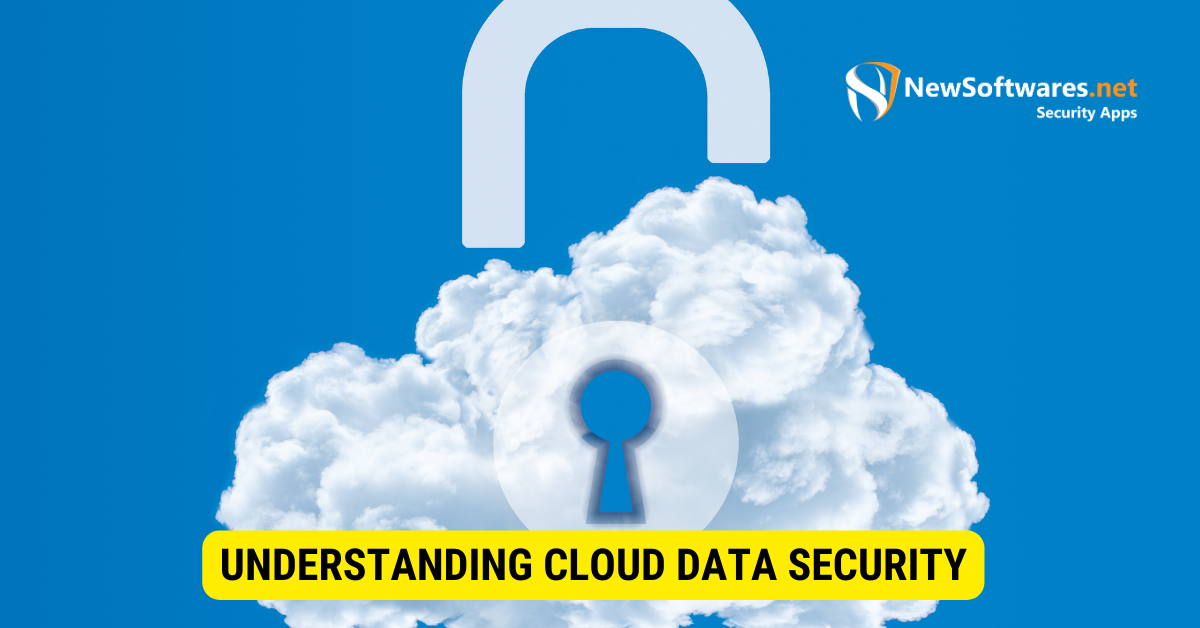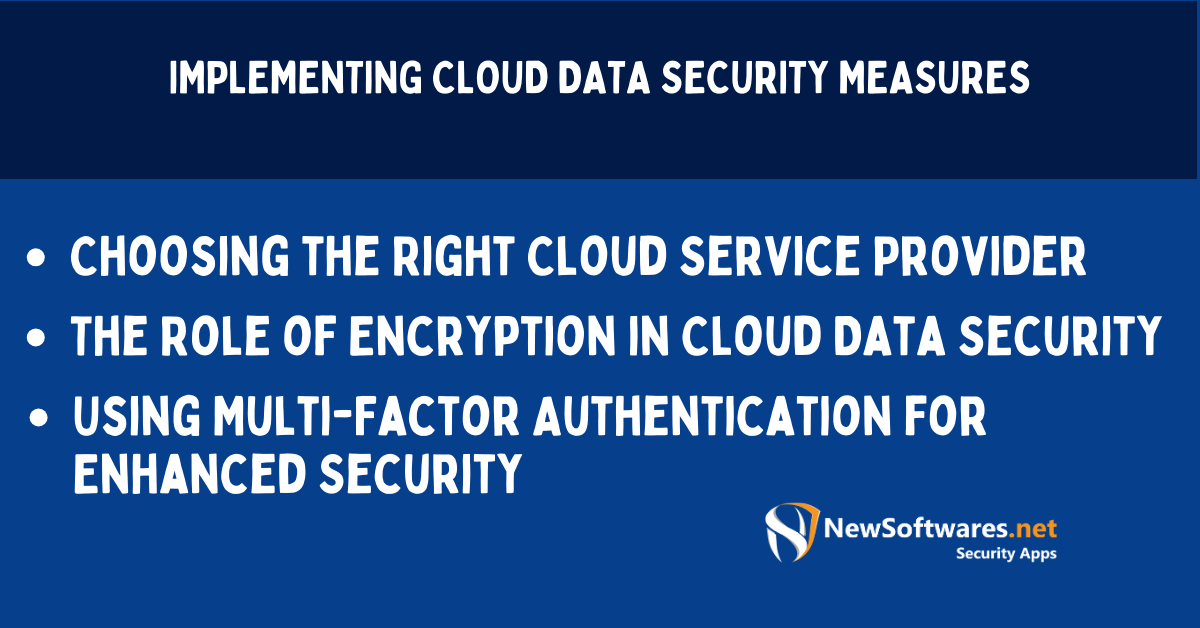Secure cloud data by using strong encryption, setting appropriate access controls, and opting for reputable cloud providers.
As more and more businesses and individuals move their data to the cloud, ensuring its security becomes paramount. Cloud data security refers to the events and practices put in place to protect data stored in the cloud from illegal access, data breaches, and other potential threats. Understanding cloud data security is essential for anyone who wants to protect their valuable information. We will delve into the status of cloud data security, basic concepts in cloud data security, and identifying potential threats to cloud data. Additionally, will discuss implementing cloud data security measures, maintaining cloud data security, and the legal and compliance aspects involved.
Understanding Cloud Data Security

Data security is a critical issue when it comes to cloud computing. The importance of cloud data security cannot be overstated, as storing data in the cloud means relying on third-party service providers to protect sensitive information from unauthorized access. Cloud data security ensures the confidentiality, integrity, and availability of data stored in the cloud. Organizations and individuals can safeguard and maintain control over their data by implementing robust security measures.
The Importance of Cloud Data Security

One of the primary explanations for the growing popularity of cloud services is their ability to provide cost-effective storage solutions. However, the convenience of the cloud should not outweigh the importance of securing data. Cloud data security is crucial because it prevents unauthorized access, minimizes the risk of data breaches, and protects sensitive information from being compromised.
Furthermore, complying with data protection regulations and industry standards is another reason why cloud data security is essential. Organizations storing personal data can face significant legal consequences if they fail to meet the requirements.
Furthermore, cloud data security is vital in building trust with customers and clients. When individuals or organizations entrust their data to a cloud service provider, they expect their information to be handled with the utmost care and security. By prioritizing cloud data security, service providers can establish a reputation for reliability and trustworthiness, attracting more customers and retaining existing ones.
Basic Concepts in Cloud Data Security
Cloud data security is built upon a set of fundamental concepts. Encryption, authentication, and access control mechanisms are essential to any robust cloud data security strategy.
Encryption is the process of converting data into a format that is unreadable without the decryption key. By encrypting data before storing it in the cloud, even if an unauthorized party gains access to the stored data, they won’t be able to read or use it without the decryption key. This provides an additional layer of protection.
Authentication ensures that only legal individuals have access to the stored data. Implementing multi-factor authentication, such as demanding a password and a unique identifier, enhances cloud data security. Access control mechanisms, including role-based access control (RBAC), further restrict specific users’ privileges and determine what actions they can perform on the data.
In addition to encryption, authentication, and access control, another crucial concept in cloud data security is data backup and disaster recovery. Cloud service providers often have redundant systems and backup procedures to ensure data is not lost during a system failure or natural disaster. These backup and recovery mechanisms add an extra layer of protection and ensure business continuity.
Furthermore, continuous monitoring and auditing are essential in cloud data security. By regularly monitoring and auditing the cloud environment, establishments can promptly detect and respond to potential security threats or vulnerabilities. This proactive approach allows for timely mitigation of risks and ensures the ongoing security of stored data.
Lastly, employee education and awareness play a significant role in cloud data security. Organizations must provide comprehensive training to their employees on best practices for data security in the cloud. This includes educating workers about the risks associated with phishing attacks, social engineering, and other common security threats. By developing a culture of security awareness, organizations can minimize the likelihood of human error leading to data breaches.
Identifying Potential Threats to Cloud Data
Understanding and identifying potential threats is crucial for effectively securing data in the cloud. By being aware of the common types of cloud data threats and assessing your cloud data vulnerability, you can establish appropriate security measures and mitigate the risks of storing data in the cloud.
Organizations must be aware of several common threats when it comes to cloud data. Unauthorized access is one such threat, which occurs when someone gains unauthorized entry to a cloud storage account or a cloud service provider’s infrastructure. This can happen due to weak passwords, compromised credentials, or vulnerabilities in the cloud provider’s security measures.
Data breaches are another significant threat to cloud data security. These breaches involve the unauthorized acquisition, disclosure, or destruction of sensitive data. Cybercriminals often target cloud storage systems because they can gain access to a large amount of valuable data in one go. Administrations must have robust security measures to prevent and detect data breaches.
Insider threats pose a unique challenge to cloud data security. These threats refer to malicious activities carried out by individuals authorized to access the data. It could be an employee with malicious intent or someone who inadvertently compromises the security of the data. Organizations must have strict access controls and monitoring mechanisms in place to mitigate the risk of insider threats.
Malware attacks are yet another type of threat that cloud data can face. These attacks involve attempts to infect cloud systems with malicious software, jeopardizing the stored data. Malware can be introduced through various means, such as phishing emails, malicious downloads, or compromised third-party applications. Organizations must have robust antivirus and anti-malware measures to protect their cloud data from such attacks.
Assessing Your Cloud Data Vulnerability
Assessing your cloud data vulnerability is an essential step in securing your data. Conducting thorough security audits and regularly testing the security measures implemented can help identify vulnerabilities and weaknesses. This allows you to make informed decisions and implement appropriate security controls to protect your cloud data effectively.
Organizations can assess their cloud infrastructure, access controls, encryption mechanisms, and incident response plans during a security audit. Organizations can classify and address potential weaknesses by conducting vulnerability scans and penetration tests before malicious actors exploit them.
Regularly testing the security measures implemented is crucial to ensure their effectiveness. This can involve simulating various attack scenarios, such as phishing attempts or malware infections, to assess the resilience of the cloud data security measures. By regularly testing and updating security controls, organizations can stay one step ahead of potential pressures and protect their cloud data more effectively.
In conclusion, understanding the common threats to cloud data and assessing your cloud data vulnerability are critical steps in securing your data. By implementing appropriate security measures and regularly testing and updating them, organizations can mitigate the risks of storing data in the cloud and ensure their valuable information’s privacy, integrity, and availability.
Implementing Cloud Data Security Measures

Implementing robust cloud data security measures is key to protecting your valuable information. Choosing the right cloud service provider, considering the role of encryption, and utilizing multi-factor authentication are all important aspects.
Choosing the Right Cloud Service Provider
Not all cloud service workers offer the same level of security. When choosing a provider, it is essential to consider their security practices, certifications, and track record. A reputable provider should have stringent security measures to protect your data. Additionally, make sure they comply with industry standards and regulations.
The Role of Encryption in Cloud Data Security
Encryption plays a vital role in cloud data security. Encrypting your data before it is stored in the cloud adds another layer of protection. Even if someone manages to access the data, they won’t be able to read it without the decryption key. Utilizing strong encryption algorithms and securely managing encryption keys is critical to maintaining the confidentiality of your data.
Using Multi-Factor Authentication for Enhanced Security
Multi-factor confirmation adds an extra layer of security to your cloud data. You significantly reduce the risk of unauthorized access by requiring multiple forms of ID, such as a password and an exclusive code sent to your mobile device. Implementing multi-factor authentication for your cloud storage accounts provides an additional barrier, making it harder for potential attackers to compromise your data.
Maintaining Cloud Data Security
Securing your data in the cloud is an ongoing process. Regular audits and updates for security maintenance and training and awareness efforts are crucial for maintaining cloud data security.
Regular Audits and Updates for Security Maintenance
Regular security audits allow you to identify any vulnerabilities that may have arisen since the initial implementation of security measures. Additionally, staying up-to-date with security updates and patches your cloud service provider provides is essential. Ensuring that your security controls align with the latest best practices and recommendations helps minimize the risk of data breaches.
Training and Awareness for Cloud Data Security
Proper training and raising employee awareness about cloud data security are integral to maintaining a secure environment. Educating users about potential risks and best practices regarding data handling and recognizing and reporting security incidents can reduce the likelihood of data breaches caused by human error or social engineering attacks.
Legal and Compliance Aspects of Cloud Data Security
Aside from the technical measures, legal and compliance aspects play a significant role in cloud data security. Understanding data privacy laws and regulations and ensuring compliance with industry standards are essential considerations.
Understanding Data Privacy Laws and Regulations
Depending on your location and the nature of the data you store, you may be subject to data privacy laws and regulations. Familiarize yourself with the applicable legal requirements and ensure that your cloud data security practices align with these regulations. This includes obtaining consent, providing adequate data protection measures, and implementing proper data retention and deletion policies.
Ensuring Compliance with Industry Standards
In addition to legal obligations, complying with industry standards is equally important. These standards, such as the ISO 27001 certification, guide best practices for information security management systems. Adhering to industry-recognized standards demonstrates your commitment to maintaining a high level of security and can enhance your reputation as a secure and trustworthy organization.
Key Takeaways
- Encrypt data both in transit and at rest.
- Use strong, unique passwords and enable multi-factor authentication.
- Understand and configure access permissions carefully.
- Regularly review and audit data access and usage.
- Choose cloud providers with strong security reputations and certifications.
FAQs
Q: Is cloud data encryption automatic?
A: Some providers offer it, but always verify and possibly add your layer.
Q: How do I manage access controls?
A: Through the cloud provider’s management console or dashboard.
Q: Can cloud providers access my data?
A: Reputable providers have strict policies against it; always read terms and agreements.
Q: How often should I audit data access?
A: Regularly, depending on sensitivity. Monthly or quarterly is common.
Q: What certifications should a cloud provider have?
A: Look for ISO 27001, SOC 2, and PCI DSS, among others.
Conclusion
In conclusion, securing data in the cloud is crucial to safeguarding and maintaining control over sensitive information. Understanding the importance of cloud data security, basic concepts in cloud data security, and identifying potential threats is fundamental to developing an effective security strategy. Implementing robust security measures, regularly maintaining security controls, and ensuring compliance with legal and industry standards contribute to a comprehensive cloud data security approach. By staying informed, proactively managing risks, and following best practices, persons, and organizations can mitigate the potential risks and confidently embrace the benefits of cloud computing.
